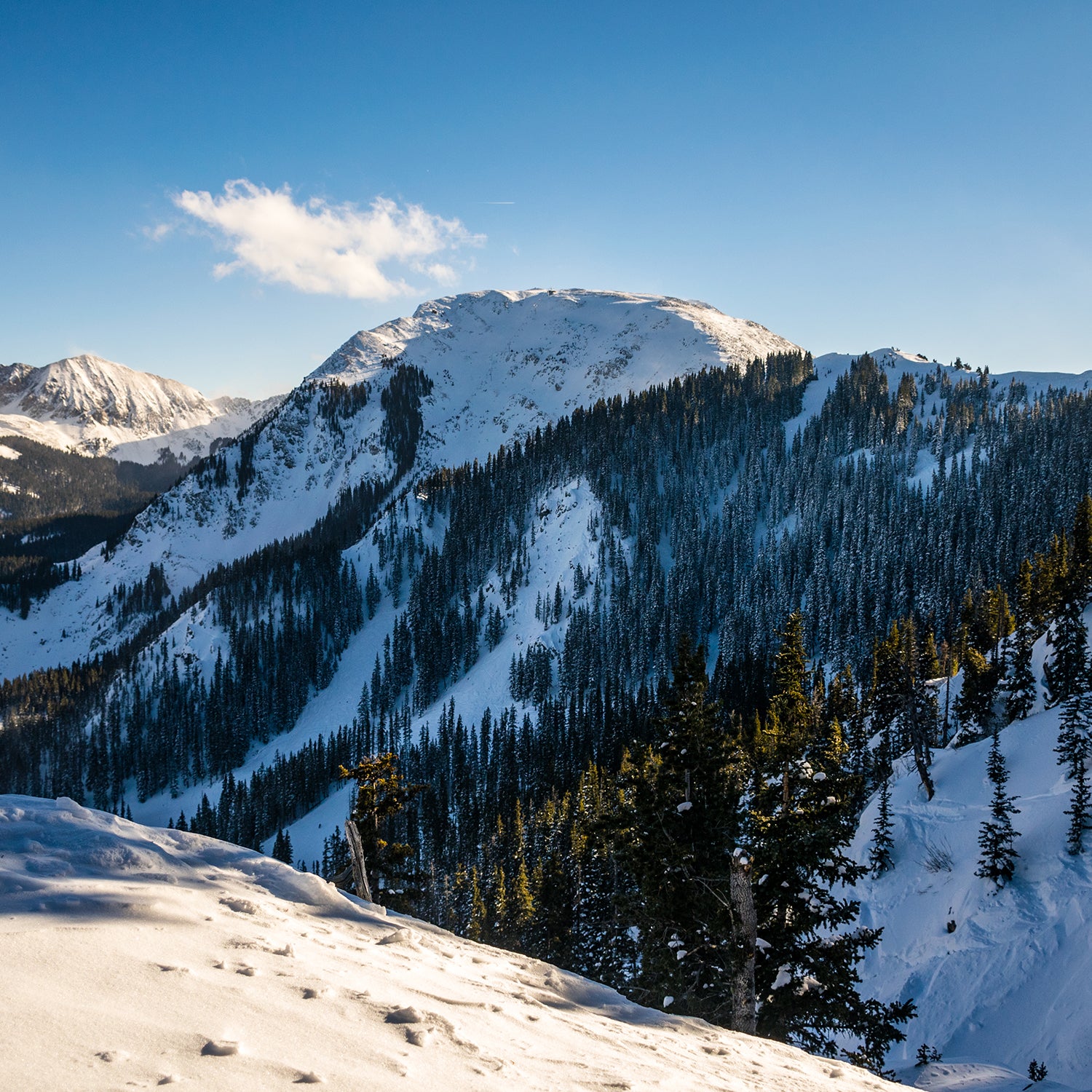On January 17, a catastrophic inbounds avalanche released in open terrain on the K3 Chute of Taos Ski Valley’s 12,481-foot Kachina Peak. The resulting slide ripped to the ground, capturing two skiers and depositing them in a debris pile reportedly 150 yards long and deeper in spots than a 20-foot probe. Both skiers, 26-year-old Matthew Zonghetti, of Massachusetts, and 22-year-old Corey Borg-Massanari, of Colorado, died. , the deaths were the first avalanche fatalities in Taos’s 64-year history. These were deep burials (six-plus feet), which are rarely survived even in the��best of circumstances.��
Again, the avalanche occurred inbounds on open terrain. Neither skier did anything wrong that day. As with all avalanche deaths, whether inbounds or out, they were simply in the wrong place at the wrong time.
In the aftermath of such tragedies, there’s a tremendous sense of grief and an outpouring of support, specifically to the families who have lost a loved one, but also to the first responders and skiing community. And then, later, skiers and the wider public tend to ask three questions: How can avalanches happen inbounds on controlled terrain? What happens now? And, are inbounds avalanches becoming increasingly common?
I’ve done extensive reporting on this subject, and the answer to the first question—how can it happen?—is that, well, it’s complicated. Avalanches are an inherent risk of resort skiing and snowboarding. And they always will be. No matter how many explosives ski patrol tosses, the risk never goes to zero. It can’t. Avalanches don’t work that way.
Here’s a primer, with an apology to the avalanche professionals out there for dumbing it down.��Most deaths—inbounds and out—are attributed to what are called slab avalanches, as opposed to loose or wet slides. In simple terms, a slab is a layer (or many layers) of consolidated snow on top of a layer (or many layers) of unconsolidated snow or icy��crust. When you hear ski patrol blasting during or immediately after a storm, they’re typically concerned with what are��known as surface or storm slabs.��The fear is that the new snow layer isn’t bonded to the surface snow beneath it. Storm slabs can be easy to predict by watching the weather, but they can be hard to pinpoint on a mountain, thanks to what avalanche forecasters refer to as spatial variability—the wind and the terrain decides the location. At a ski area, that can mean such pockets of unstable snow go untriggered by the snow-safety team out running its routes or by the bombs��they throw. Spatial variability is the number one reason why avalanches are inherent to ski areas.
Avalanches are an inherent risk of resort skiing and snowboarding. And they always will be.
But there’s a more insidious type of slab that’s even more closely tied to inbounds avalanches. It’s often called a “persistent slab.” Scientists spend lifetimes studying them, but in the briefest of explanations, a persistent slab means that a weak layer (or layers) is buried beneath the surface of the snowpack. The weak layer often takes the form of the type of loose crystals that make for shitty snowballs—they don’t stick to each other. As with storm slabs, persistent slabs are spatially variable. But while the weak layers are easy to identify by digging a deep test pit, knowing when or if one will lead to a slide—especially with deep instabilities—is perhaps��the most challenging tasks in the outdoor world. Avalanche forecasters like to say that such layers are “guilty until proven innocent,” and ski resorts spend tens of thousands of dollars each winter testing such deep instabilities with explosives. But of course you can never prove anything with avalanches unless you throw a bomb and make one slide. Those weak layers can get worse over time depending on the weather; the weight of new snow can make them more tenuous, and they also come with nearly impossible-to-predict triggers, such as��when the weak layer encounters a rock and you ski near the rock, or when the snow above gets scoured by the wind so that a skier can interact with the suspect layer.
For all these reasons and many, many more, avalanches, like the weather, are a . And like the weather, they’re inherent to the mountains—avalanche-controlled or otherwise. I’ve witnessed inbounds avalanches that have carried skiers over cliffs and inspected firsthand the evidence of other massive inbounds slides. In one case, the terrain had been open for many months.
I’ll leave it to the avalanche professionals on the scene at Taos to determine the specifics of the Kachina Peak slide, but as a well-read��20-year veteran of backcountry skiing, the K3 avalanche was almost certainly not a storm slab, but rather a deep release of a persistent slab. Images and firsthand accounts of the Kachina slide would indicate that the entire snowpack broke all the way to the ground and ran the length of the avalanche��path. A U.S. avalanche forecaster might call that a Category 5 event: it went as deep as it could possibly go, for as long as it could possibly go.��
No resort advertises the fact, but as skiers��we live with this type of residual uncertainty much of the time we ski big terrain. If we weren’t collectively OK with that small level of risk, we would never ski off the low-angle groomers. So, as with collisions with other skiers, slips from chairlifts, and falls from cliffs, avalanches are considered an inherent risk to resort skiing and snowboarding. This was recently confirmed in the Colorado courts after a lawsuit was filed in the wake of two avalanche fatalities that occurred on the same day at separate resorts in 2013. Avalanches, the Colorado Supreme Court , are indeed an inherent risk in��the sport—and resorts, barring clear-cut negligence, are protected from avalanche-related lawsuits.��That decision further validated Colorado’s Skier Safety Act, which never specifically mentions avalanches but��does address the inherent dangers of snow. ����
And that speaks directly to the second question. What happens in the wake of a tragedy like the one that occurred on Kachina? My long-standing industry sources tell me that in the immediate aftermath, there will be an investigation. Typically conducted by the resort (though a Forest Service law-enforcement officer and avalanche forecaster may be involved), the snow-safety team and the resort’s risk-management staff will immediately review the mitigation work that was performed, interview all employees and witnesses with a corporate attorney present, analyze the decision-making process that led the resort to open the terrain, and debrief��the emergency response. By the end of the investigation, the resort will have a feel for��whether it was negligent in its��duties or if it��did everything in its power to operate safely.��
Later,��lawsuits will likely be filed. But if Colorado’s 2013 incidents��serve��as precedent, the local courts will look to state law for guidance as they try to determine in favor of the plaintiffs (negligence on behalf of the resort) or the ski area (assumption of risk on behalf of the skiers). Every state’s body of case law is different, every case is different, and negligence trumps all. But while there’s no certainty that a judge will rule��in favor of the resort if and when a case makes it to the state supreme court, New Mexico’s own Skier Safety Act would surely come into play—specifically the bit about snow’s��inherent risks. The language��is written into New Mexico’s act, which uses the same wording as Colorado’s:
“Each skier expressly assumes the risk of and legal responsibility for any injury to person or property which results from participation in the sport of skiing, in the skiing area, including any injury caused by the following: variations in terrain; surface or subsurface snow or ice conditions.”
It may not be particularly clear, but “surface and subsurface conditions” includes the types of avalanches discussed above.��
We’d all benefit from treating mountains and mountain environments like the inherently dangerous places they are.
Given the law, the case-law precedent, the nature of avalanches, and the fact that Taos Ski Valley has a reputation for diligent and extremely cautious avalanche-mitigation work and terrain opening, the bar for negligence in any court proceedings will be set pretty high. As it should be. Without those protections, resorts might not be able to operate in what many of us would consider challenging and fun terrain. In the worst-case scenario, if we as skiers don’t assume some risk, expert skiing on unique western terrain will end.
The fact that most skiers today don’t appear to know about the risk of inbounds avalanches would seem to indicate that the ski industry isn’t marketing that particular risk very well to skiers. But it’s also��true that��despite the recent loss of life in Colorado and New Mexico, deaths by inbounds avalanches are exceedingly rare. The latest fatalities amount to the 10th and 11th, including patrollers, in the U.S. since 2008. That translates to roughly one avy-related death per��year out of 50 million annual skier visits.
As to whether inbounds avalanche deaths are on the rise, it’s probably too soon to say. We know anecdotally that—equipped with better gear—skiers and snowboarders are spending more time in deep powder on bigger terrain. And we also know that across North America, resorts have moved to open more of that terrain. But it would be conjecture to draw too much of a correlation yet. In fact, over the decades��resorts have become markedly safer in terms of inbounds avalanches. In total, 45 skiers and snowboarders died from inbounds avalanches . But while between 1951 and 1979, roughly 10 percent of all U.S. avalanche deaths occurred inbounds, by 1994 that inbounds number had dropped to 1.3 percent—which, even though it reflects the growth of backcountry skiing and snowmobiling (deaths moved to the backcountry), is still a sizable drop and hints at the adoption of avalanche mitigation across the resort industry.
, that means,��over the past ten years, 3.5 percent of those fatalities have been inbounds.��Which, if borne out, hints at a slight uptick. Or perhaps it’s a statistical anomaly and inbounds avalanche deaths will quickly taper off again. Moving forward, though, with avalanche control getting more sophisticated due to new mitigation devices like and , the control work might just stay ahead of it. Let’s hope so.
In the meantime, we’d all benefit from treating mountains and mountain environments like the inherently dangerous places they are. We owe that to the expert skiers who—through no fault of their own—died while skiing in this big terrain.��Knowing that avalanches are an inherent risk in no way softens that human tragedy. But we can learn from the loss and remember that��despite the grooming and the bubble chairs, the heated parking lots and the mid-mountain macchiatos, our high peaks are forever wild—and they always will be.


